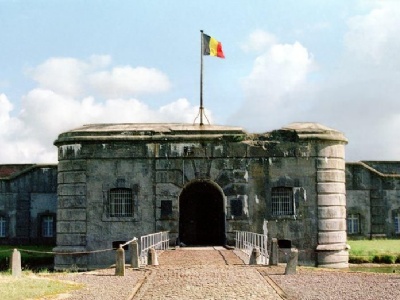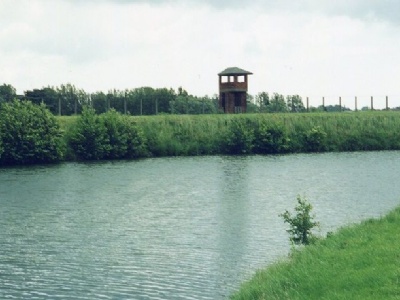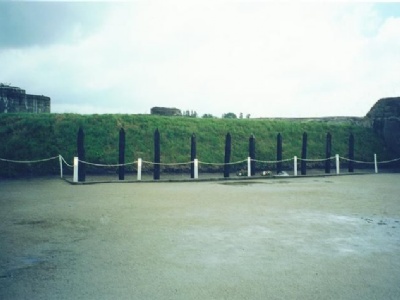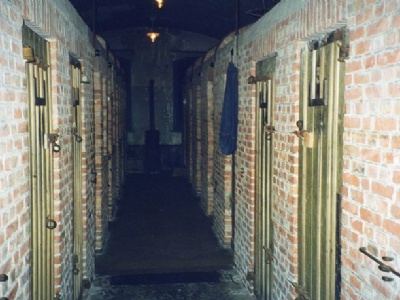Breendonk
Just outside a small town called Willebroek, between Antwerp and Brussels, fort Breendonk was built between 1909 and 1914. The fort was part of a larger line of defense and when the First World War broke out in August 1914, the fort was mobilized. In october 1914, the fort was subjected to an intense German artillery fire and was occupied by the germans. After the end of the First World War in 1918, the fort came time to time to being used by the Belgian army. After the German attack on France and the BeNeLux countries in may 1940, the fort became Belgian army headquarters for a short period. In september 1940, the german Security Services (SD) and the Security Police (SIPO) took over the fort and used it as a transit camp for various categories of prisoners. About half of the prisoners were Jews and at the end of 1940 separate barracks were built for Jews who were thus separated from other prisoners. This separation lasted until 1942 when the Jews were transferred to the Jewish assembly camp established in the Dossin barracks in Mechelen.
Breendonk was first guarded only by German SS units but later Belgian SS unit also served as guards. Initially, conditions were acceptable, but after the German invasion of the Soviet Union, the situation deteriorated. Lack of food, medicine, torture, ill-treatment and diseases became part of everyday life for the prisoners. Breendonk was not a concentration camp but a prison, most of which spent about three months in the fort before being sent on to camps in Germany, Austria and Poland. At the end of August 1944, the Germans evacuated the fort and the prisoners were first sent to Vught in Holland and later to Germany. When American troops arrived to the fort in early September, it was empty but intact. About 3500 prisoners went through the fort, of which about 600 were imprisoned at one and the same time. Between 300 – 400 prisoners were executed in Breendonk, mainly by hanging and firing squad.
Current status: Preserved with museum (2000).
Address: Brandstraat 57, 2830 Willebroek.
Get there: Car.
Follow up in books: Kogon, Eugen: The Theory and Practice of Hell: The German Concentration Camps and the System Behind Them (2006).






All the countries occupied by the Germans had their collaborators who in one way or another served the occupying power and some of them have become symbols of treason for posterity. In Norway there was Quisling, perhaps the greatest symbol of them all, in France Petain, in Holland Anton Mussert and in Belgium there was Leon Degrelle. Degrelle was an educated lawyer who in 1930 had founded a movement with religious and fascist elements called the Rexist movement. The movement was also passionate about Nazism and looked with enviable eyes at how Hitler and the National Socialists grew strong in Germany. In the 1936 Belgian parliamentary elections, the movement was given 21 seats. When Germany attacked Belgium in May 1940, Degrelle was arrested by the Belgian authorities and sent to France but was released by the German occupiers in connection with the fall of France. The Rexist movement and Degrelle subsequently became the extended arm of the German occupying power in Belgium.
In 1941, Degrelle volunteered for the Waffen-SS and served on the Eastern front. He proved himself in battle, rose in military ranks and became Germany’s most foreign decorated soldier. He received the Knights Cross personally from Hitler. On this occasion, according to Degrelle himself, Hitler said, ”if I had ever had a son, I would have hoped that he had been like you”. If Hitler really said that is debatable. After the war, he fled via Norway to Spain, where he obtained Spanish citizenship. He thus escaped extradition to Belgium. During his time in Spain, he continued to express his support for Hitler and he was active in a Spanish neo-Nazi organization. Even after Franco’s death in 1975, he was able to continue living undisturbed until he died at the age of 88 in 1994.
But Degrelle has not only become a symbol of treason he has also become a highly regarded person of neo-Nazi circles around the world. Degrelle never renounced his political values, his hatred of communism and admiration for Hitler, which he considered to be the greatest genius of all time. At the end of his life he answered the question whether he regretted anything with the words, ”just that we lost” (with we he meant Germany). Add this to his personal encounters with Hitler and war awards, Degrelle fulfills everything that neo-Nazis expect from a role model.